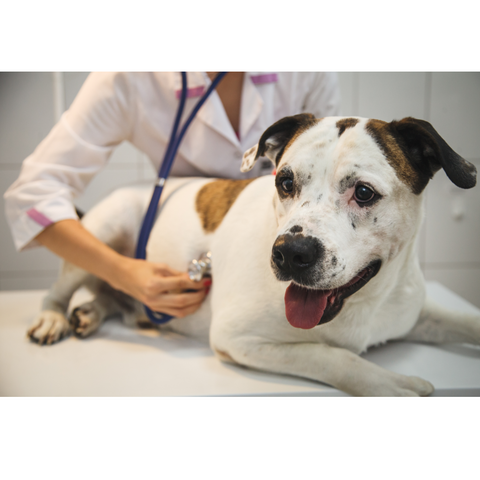
A Guide To Heart Disease In Dogs
November 19th 2020
It is estimated that up to 15% of UK dogs will suffer from some kind of heart condition during their life. However, unlike in humans, heart attacks in dogs are very rare and the most common condition that they will suffer from is heart failure which is secondary to another condition.
This secondary condition can be due to heart defects the dog is born with or different types of heart disease that develop over time (and certain breeds may be predisposed to), or in rarer cases it can be secondary to problems elsewhere in the body.
Anatomy of the canine heart
The heart is a muscular organ that pumps blood around the body delivering oxygen and nutrients to where they are needed and removing toxins such as carbon dioxide and metabolic waste. This waste travels in the blood stream and is removed when it passes through the liver and kidneys.
The dog’s heart contains four chambers, these are the atria (two upper chambers) and ventricles (two lower chambers). The right ventricle pumps deoxygenated blood to the lungs so it can collect oxygen. The left ventricle pumps oxygenated blood from the lungs around the body. In simpler terms, the heart can be described as two pumps stuck together. The right pump gets blood to the lungs and the left pump pushes blood around the rest of the body.
The heart has four valves: Mitral, Tricuspid, Pulmonary and Aortic. The Tricuspid valve is found between the right atrium and right ventricle and the Mitral valve is found between the left atrium and left ventricle. Blood is delivered to the atria via blood vessels and then passes through into the ventricles via these valves. Usually, the valves form a tight seal to stop blood washing back into the atria, however with valvular disease the valves have degenerated and allow blood to leak back through.
Types of heart disease in dogs
Heart disease can either be congenital (present from birth) or acquired (develops over time). Some of the congenital conditions appear to be hereditary (passed on from parents to offspring) and are found in certain breeds of dog. However, in this article we are going to focus on acquired heart disease which affects 95% of dogs with cardiac problems.
Unlike humans, dogs don’t suffer from heart attacks and hardening of the arteries. However, they can suffer from heart failure which occurs when the blood output from the heart starts to decrease relative to the amount that is coming back to the heart.
Congestive heart failure in dogs
Heart failure can occur on either side of the heart or be seen on both sides, but it is not a disease itself; it is a consequence of another disease process affecting the heart to a degree where it is affecting the overall function. Most commonly one side of the heart will fail, and a vet will describe it as either right or left sided congestive heart failure. When one side of the heart/pump is diseased it will have to work harder to ensure its output keeps up with the input coming from the other healthy side.
Over time as the disease progresses the extra workload increases and eventually there may come a time where it can no longer keep up, this is then when you start to see signs of heart failure. The decrease output of the ‘failing’ side causes blood to accumulate upstream in the blood vessels, changing the balance of pressure between blood vessels and tissues. Upstream from the left side of the heart is the lungs where the blood just passed through to pick up oxygen and upstream for the right side of the heart is the large central vein running back to the heart through the abdomen and the liver.
The alteration in pressures causes fluid in the blood to leave the vessels and congest the surrounding tissues, so in the case of left sided failure the fluid accumulates in the lungs and for right sided failure it affects the abdomen and liver. The accumulation of the fluid then causes specific clinical signs we identify with a certain side of heart failure such as abdominal swelling in the case of right sided failure and coughing and difficulty breathing for left sided.
There are many different diseases that can lead to heart failure but the most common are acquired diseases affecting the valves in the heart especially the mitral valve and disease that affects the heart muscle contracting.

Mitral Valve Disease in dogs (MVD)
One in ten dogs will develop some sort of heart disease within their lifetime and the most common (80%) is chronic valvular disease (CVD), also known as endocardiosis. Although, the heart has 4 valves the mitral valve is the most commonly affected (Mitral Valve Disease).
One of the first signs that your dog may be suffering from heart disease is when your vet says they can hear a ‘heart murmur’. The noise they are actually listening to is the blood leaking back through the mitral valve. However, in many cases a minor heart murmur in dogs or leaky valve is no cause for concern and the dog may lead a happy and normal life with no symptoms.
A larger leak will mean that the heart is having to work harder to pump the same amount of blood around the body, causing the heart to eventually fail as mentioned above. Further tests such as an ultrasound may be required to determine the severity of the problem.
Dogs over the age of 8 years old are more likely to be diagnosed with MVD than younger animals and unfortunately there does seem to be a breed disposition. Smaller dogs such as Cavalier King Charles Spaniels, Miniature and Toy Poodles, Schnauzers, Chihuahuas, Fox terriers and Boston terriers all appear to be more likely to suffer from this heart condition.
Signs of MVD
Dogs affected with MVD are progressively struggling to pump blood around the rest of the body and as fluid starts to accumulate up stream this preventing oxygen being picked up affectively in the lungs. Therefore, dogs suffering can show signs including fainting, reduced exercise tolerance- lack of stamina, struggling to breathe, lack of energy, poor appetite, a hacking cough or noise like they are trying to clear their throat.
Dilated cardiomyopathy in dogs (DCM)
Another 5-10% dogs with acquired heart disease suffer from a different condition called Dilated Cardiomyopathy (DCM) where the ventricles become enlarged as the heart muscle becomes weak and stretched. This causes the heart to stop pumping blood efficiently. Again, there are certain breeds which are more commonly affected including Doberman, Great Dane, Cocker and Springer Spaniels, American Cocker Spaniel, Boxer, Dalmatian, Afghan hound, Newfoundland and St. Bernard.
Signs of DCM
Dogs that suffer from DCM can show signs similar to MVD as it is the left chamber most noticeably effected (the one with the bigger job pumping blood around the whole body) – the same side as for MVD. Signs include weakness, fainting, reduced exercise tolerance, getting tired quickly, and excessive panting or coughing.
As the condition progresses and effects on the right side of the heart signs become more noticeable. The abdomen appears larger as it fills with fluid and this in turn will also cause heavier breathing. More advanced symptoms include laboured breathing, increased coughing, weight loss, poor appetite, an inability to get comfortable and collapse.
How is heart disease in dogs diagnosed and treated?
Your vet will usually start by listening to your dog’s heart with a stethoscope and checking their pulse. They may also listen to the lungs to see if they can detect any associated changes that can occur with heart disease and palpate their abdomen. If they suspect a heart problem, further tests will be required to determine the type and severity of condition your dog has.
Further tests will include x-rays and/or ultrasounds to detect the size and shape of the heart and the function of the chambers and valves. An Electrocardiogram (ECG) which measures the electrical activity of the heart and can detect heart rate and rhythm may also be used and routine blood or urine tests may be done to check if there are any concurrent issues such as kidney failure.
Sadly, heart disease cannot be cured but if it is treated early enough, with the correct medication and some dietary management, quality of life can be maintained for longer. There are variety of medications that can be used to manage and slow down the progression of heart disease and the development of heart failure and your vet will be able to advise you on the best ones for your individual dog.
The earlier the problem is detected the more successful the treatments can be. Medications include vasodilators to increase/relax blood vessels, allowing a greater volume of blood through the vessels reducing the pressure on the heart and agents called positive inotropes that to help increase the force at which the heart muscle beats.
They don’t increase the speed that the heart beats, but they help to increase the strength of the muscular contraction, forcing more blood through with each pump. In the later stages of heart failure there are other drugs such as diuretics that can be introduced to reduce the fluid accumulation in the body.
As well as medication, nutrition can play an important part in maintaining quality of life for heart patients and our second article in this series explains more about the role nutrition can play in the management of heart disease and heart failure.

 Shop Dog
Shop Dog
 Shop Cat
Shop Cat
 Vet Know-how
Vet Know-how Contact
Contact



